| Christoph Petermann | Homepage |
|
144 MHz
9 Element (DK7ZB)
|
Introduction
Around Christmas 2003 I decided to give 2m (144 MHz) another "kick". I made my first "digital" Meteorscatter contacts using only 45 watts of output on a 17 element Tonna antenna with 22m of H2000 Flex coaxial feedline. The 17 element is no optimum and its position on my telescopic tower is below my 50 MHz antenna. For my small antenna tower these two antennas are almost the maximum load it can carry. I have looked to the GT tables provided by Lionel Edwards VE7BQH and found the DK7ZB 9 ele to be a good antenna for my purpose. Its gain is almost identical to the 17 element but is much shorter (5m compared to 6,7m). The mechanical data are provided on the internet and I have put these dimensions to my favourite simulation program EZNEC. The results meet exactly the values shown at various places in the web. The pattern is very clean with a very good F/B ratio. Then I calculated also the 2m antenna combined with the 6m antenna (described on these pages). I quickly came to the result that I had to swap: 50 MHz to the lower and 144 MHz to the upper position.
A compromise
I tried to find out, if there will be any advantage, if I slightly elevate the antenna's beaming direction from the horizon by a few degrees upwards. Yes this gives some advantage: First regarding the German RegTP regulations concerning emission a lot less energy will be radiated in the neighbours houses compared to the antenna pointed to the horizon. This is ca 8 dB less and enables me to use a power amplifier. Second this certainly will help for Meteorscatter. Not for the long distances, but for the range between about 800 .. 1500 km. The loss to the horizon is only about 1 .. 2 dB. EME will suffer from ground gain effects that will be less than when pointing the antenna to the horizon. Regarding my surrounding I will certainly have some ground gain available. On the other hand the antenna will pick up less noise from the ground and that is good as I live quite in the center of the village. So I will elevate the antenna by about 15 degrees. If I come to the conclusion, that it does not work, I will point it to the horizon.
Preamplifier Position
Between the PreAmp and Antenna I have about 3.5m of low loss AIRCOM cable. Later on the antenna low-noise preamplifier will be mounted very close to the dipole about 25 cm behind. Others have done this with good success. This will give me some extra sensitivity hopefully.
First Impression
On 14 March 2004 I have mounted the antenna on top of my tower wit 15 degrees of elevation. SWR is less than 1:1,2. Noise sounds down compared to my 17 ele F9FT which pointed to the horizon. With the sun in 6 degrees elevation sunnoise is very fine detectable. By end of March 2004 I made the first Moonbounce contacts with this antenna.
Outlook
In the next autumn I will take down the 50 MHz antenna for winter time and hopefully add a 2nd 9 element and an elevation system. This will allow me doing some serious EME work on 144 MHz hopefully. I heard of others using two of these yagis with good success.
Tom DJ5RE has worked successfully EME with 2 slightly larger M2 antennas. His 12 ele yagies have 0,4 dB more gain.
Mechanical dimensions
I bought the antenna from WIMO. This antenna is of good quality with stainless steel screws and hardware. To prevent water from penetration into the balun box, I put some plastic hot glue around the N connector. It took me about 45 minutes to assemle the antenna.
Table of mechanical dimensions
From The DK7ZB Site I found some different dimensions than the actual WIMO type antenna has. There are really some strong discrepancy which I cannot explain by the boom size or so.
| . | WIMO | 8 mm Elements 15 mm boom |
DK7ZB | 8 mm Elements 15 mm boom |
. |
| . | Position in mm | Length in mm | Position in mm | Length in mm | |
| Reflector | . | 1010 | 0 | 1021 | |
| Driven Element | . | . | 345 | 968 | |
| D 1 | . | 934 | 615 | 945 | |
| D 2 | 917 | 1175 | 921 | ||
| D 3 | 898 | 1870 | 906 | ||
| D 4 | 885,5 | 2675 | 895 | ||
| D 5 | 879 | 3505 | 889 | ||
| D 6 | 894 | 4345 | 900 | ||
| D 7 | 885,5 | 4980 | 888 |
Simulation results
The DK7ZB antenna (original design) in free-space
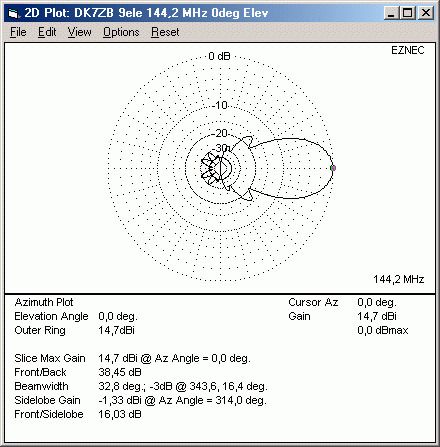
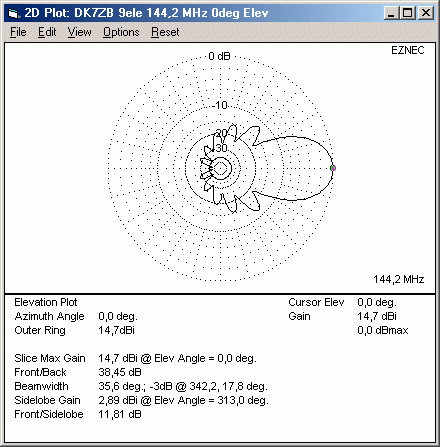
The DK7ZB antenna (WIMO Design) in free-space
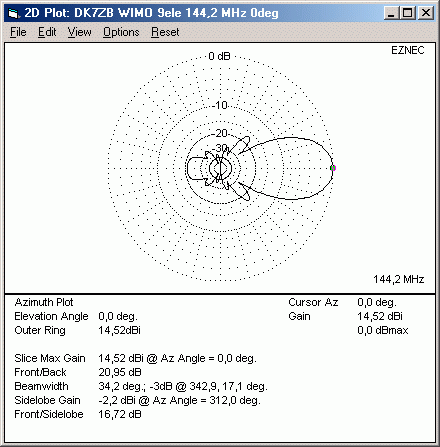
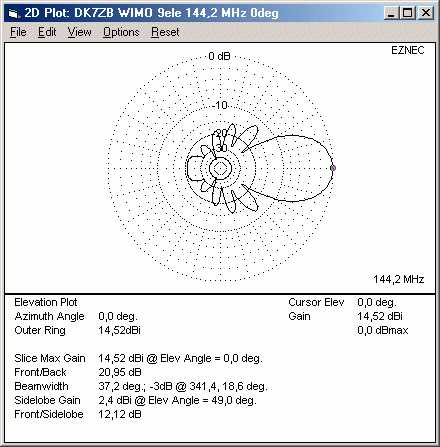
Antenna over Ground : 0 degrees elevation (left) : 15 degrees elevation (right)
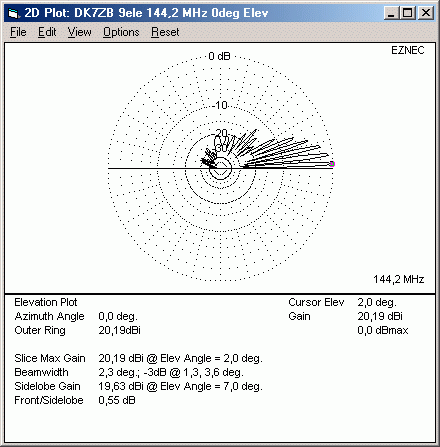

Combined with 6m (beaming 15 degrees upwards)
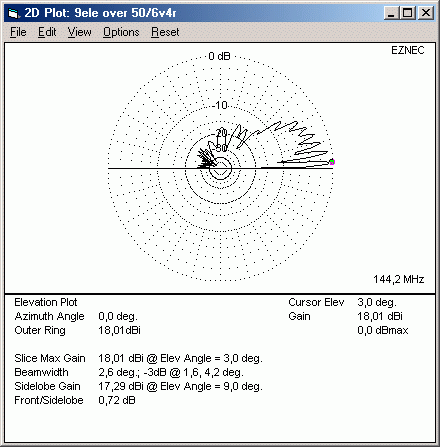
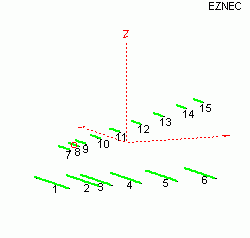
|
Text and
All Images are Copyright by Christoph Petermann DF9CY
|
GO (back) and visit my homepage